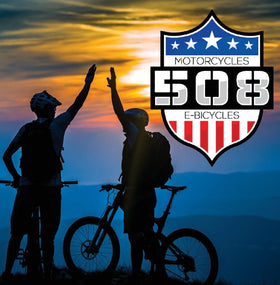E-Bikes 101: The Basics for Anyone New to Electric Biking
As electric bikes continue to rise in popularity, more people are making the switch to this convenient and eco-friendly mode of transportation. Whether you’re a first-time rider or a seasoned cyclist looking for an upgrade, finding the perfect e-bike can be challenging.
In this guide, the experts at E-Bikes 508 walk you through everything you must know to choose the right e-bike for your needs. From understanding key specifications to selecting the bike best for your lifestyle, we’re here to help you navigate the winding trail to your next adventure.

New to E-Bikes? Start Here.
Electric bikes are transforming the way people commute, exercise, and explore the outdoors. Unlike traditional bicycles, e-bikes are equipped with an electric motor that assists your pedaling; this makes it easier to tackle hills, long distances, or just a casual ride around town.
When selecting an e-bike, it’s important to understand its basic components:
- Motor: Powers your bike and can vary in strength.
- Battery: Powers the motor, and its capacity determines how far you can ride on a single charge.
- Pedal-Assist & Throttle: Pedal-assist empowers you to cycle with less effort, while throttle control enables you to ride without pedaling at all.
But beyond these basics, how do you know which e-bike is right for you? Let’s explore the different types of e-bikes and who they’re best suited for.
Which Type of Electric Bike Best Suits Your Riding Style?
E-bikes come in various styles, each designed for different types of terrain and rider preferences. Choosing the right type depends largely on where you plan to ride and what you hope to get out of your e-bike experience.
Leisure Bikes:
If you’re looking for a bike to cruise around town, run errands, or enjoy leisurely rides on paved paths, leisure e-bikes are an excellent choice. These bikes are designed for comfort and ease of use, with cushioned seats, upright riding positions, and smooth handling.
- Best For: City streets, bike paths, commuting.
- Top Features: Comfortable ride, easy handling, and a moderate motor for daily use.
Mountain E-Bikes
For the thrill-seekers who enjoy off-road adventures, mountain e-bikes are built to handle rugged terrains. Equipped with sturdy frames, powerful motors, and thick tires, electric mountain bikes can tackle steep climbs and bumpy trails with ease. If you’re passionate about mountain biking but want a little extra help on tough trails, an off-road e-bike is the perfect choice.
- Best For: Mountain trails, gravel paths, off-road adventures.
- Top Features: Strong suspension, wide tires, and powerful motors for steep climbs.

Road E-Bikes
Optimized for speed and long-distance travel, road electric bikes are designed for smooth surfaces and endurance. Whether you’re commuting or training, street e-bikes offer lightweight frames and aerodynamic designs that enable you to cover more ground with less effort. These bikes are best for riders focused on fitness or long rides on paved roads.
- Best For: Commuting long distances, fitness rides, and road cycling.
- Top Features: Lightweight frame, powerful motor, and extended range.
Key Specifications to Look For When Comparing E-Bikes
Finding the right electric bike requires more than just selecting a style. It’s important to compare the technical specifications to ensure your bike fits your riding habits and expectations.
Here’s what to consider:
- Motor Power
- Battery Capacity
- Pedal-Assist & Throttle Control
- Brakes & Tires
- Frame and Suspension
Motor Power: How Much Power Do You Need?
E-bike motors are measured in watts (W), with typical options ranging from 250W to 750W.
- 250W: Ideal for flat terrain and light use.
- 500W: A great middle ground for moderate hills and more challenging rides.
- 750W: Best for steep climbs and heavy-duty use, especially on off-road e-bikes.
Battery Capacity: How Far Can You Go?
Battery size determines the range of your e-bike. Measured in watt-hours (Wh), the higher the number, the further you can travel on a single charge. A typical range for most electric bikes is between 20 to 50 miles, but this can vary depending on terrain, rider weight, and pedal-assist settings.
Pedal-Assist & Throttle Control: How Much Assistance Do You Need?
Pedal-assist levels let you decide how much motor power you want to use. Most e-bikes offer 3 to 5 levels of pedal assist, from a light boost to full power for hill climbing. Some bikes also feature throttle control, allowing you to ride without pedaling at all, ideal for resting your legs during longer rides.
Brakes and Tires: Safety and Traction
When riding at higher speeds or on rough terrain, reliable brakes are crucial. Road e-bikes typically come with lightweight tires for faster speeds on paved roads, while electric mountain bikes offer wider, treaded tires designed to grip rough surfaces. Look for disc brakes, which provide superior stopping power, especially on steep or uneven terrain.
Frame and Suspension: Tailored to Your Riding Environment
The material of your bike frame and its suspension setup can make a big difference in comfort and performance. Mountain e-bikes often have full suspension for a smoother ride on rough terrain, while road electric bikes focus on being lightweight for maximum speed.
5 Questions to Ask During a Test Ride
The best way to determine if a bike is right for you is to test-ride it. Here are some things to check during your ride:
- How responsive is the motor when you start pedaling?
- Is the bike the right size for you?
- Can you adjust the seat and handlebars for optimal comfort?
- Are the brakes effective and smooth?
- Does the bike handle the types of terrain you plan to ride on?
At our electric bike shop, we encourage customers to test ride multiple models to ensure they leave with the perfect e-bike.

Frequently Asked Questions About E-Bikes
How fast do e-bikes go?
Most e-bikes can reach speeds of up to 28 mph, depending on the model.
Are there any laws around riding e-bikes?
Regulations vary by state, but most places require that riders follow the same rules as traditional bicycles. If you live in Massachusetts, visit our blog now to learn everything you must know about e-bike laws.
How long does it take to charge an e-bike battery?
Charging times can range from 3 to 6 hours depending on the battery capacity.
Can I ride my e-bike in the rain?
Yes, most e-bikes are water-resistant, but it’s always a good idea to avoid deep puddles and ensure your battery is properly sealed.
Do e-bikes require a lot of maintenance?
Similar to traditional bikes, you’ll need to keep the tires, chain, and brakes in good condition. Regular servicing at an electric bike shop is recommended.
Find Your Perfect Electric Bike at E-Bikes 508
At E-Bikes 508, we’re passionate about helping every rider find the perfect ride. With years of experience in the industry, our team is dedicated to offering expert advice, a wide selection of high-quality electric bikes, and a commitment to customer satisfaction.
Whether you’re looking for a smooth-riding road electric bike or a rugged electric mountain bike for off-road adventures, we’re here to guide you every step of the way. Visit us today for a test ride or shop our electric bike selection now.
